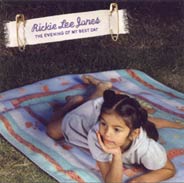Rickie
Lee Jones
The
Evening Of My Best Day
(V2)
Does anybody still remember Rickie Lee Jones? And (more important):
Does anybody still care? Jones's path was a strange one, but one that was
definitely not impossible to foresee: commercially doomed by her first album's
(Rickie Lee Jones, 1979) colossal, totally unpredictable (and obviously impossible
to replicate) success, fuelled by the megahit Chuck E.'s In Love. On that
first album, the singer sported a vocal timbre and a way of phrasing that
were quite personal (which doesn't mean that her influences, while not flaunted,
were that difficult to hear), and a repertory which nicely swam the various
currents of modern American popular music.
But the young musician (Jones was born in 1954) refused to duplicate
the successful formula of her first record, deciding instead to continue nurturing
her artistic growth - the same path travelled by an artist whose work Rickie
Lee Jones deeply knew: Laura Nyro. Hence, a follow-up album (Pirates, 1981)
that was more cerebral, enigmatic and complex than what the majority of the
American audience were ready to accept, though in time the album has proved
to have been an important example for some young singers/songwriters who at
the time were working on their craft (for instance, Suzanne Vega).
The usual (and widely publicly discussed) "personal problems"
made commercial success more difficult to reach, though very good albums were
released - check The Magazine (1984), the Walter Becker-produced Flying Cowboys
(1989) and Traffic From Paradise (1993).
Then, something changed: During the last ten years only one album
of new original material was released: Ghostyhead (1997), with its trip-hop
experiments. Two very good albums of covers (Pop Pop, released in 1991, and
It's Like This, released in 2000), plus two albums recorded live (Live At
Red Rocks, the most recent, was released in 2001) tell of a writer's block
- here we could talk at length about how certain kind of fuels, so dangerous
for one's physical health, can be nourishment for one's artistic survival.
Whatever the reason(s), the impulse for Rickie Lee Jones's recent rebirth
seems to have been one that - given the highly "personal" nature
of her art - on paper appeared to be very unlikely: George W. Bush becoming
president of the USA, and that country's political evolution.
So The Evening Of My Best Day could be defined as her "civil
rights" album, in ways that connect to the 1960s and within a stylistic
framework that longtime fans will easily recognize. The opening track, Ugly
Man, dedicated to Bush, has an air of a sing-along; an R&B push animates
Little Mysteries; and a gospel-like "call and response" gives strength
to Tell Somebody (Repeal The Patriot Act). (By the way, there are no lyrics
in the booklet, but visiting the website furnitureforthepeople.com makes it
possible to read the song lyrics and to watch some images related to the topics
of the songs.)
The nice vocal and instrumental performances of It's Like This had
made me long for an album of original material that possessed the same quality
of recording, since the instrumental and vocal timbres were superb. So I'm
very glad to report that in this particular department The Evening Of My Best
Day fully delivers. She must have spent a lot of money (her own, I suspect),
but it's the artistic intelligence at work that's really important: a track
like Second Chance - stylistically not too distant from Steely Dan (an album
by the group appears to have been referred to in the lyrics) - makes one realize
how much a similar use of the digital machines could have improved Becker
& Fagen's last couple of albums. The instrumental timbres are quite nice
and always pertinent, from Ken Wollesen drums (listen to the brushes!) (the
Bill Frisell trio being featured on two tracks) to the winds and reeds (you
remember Jerry Hey, right?), from the background vocals (Syd Straw, Eric Benet,
Grant Lee Phillips, Ben Harper) to the piano and organ (Neil Larsen, Gregg
Phillinganes), from acoustic and electric basses, drums and percussions that
are lively and natural (listen to James Gadson's bass drum) to dobro, dulcimer,
acoustic guitars and mandolins. I'd like to add that the somewhat rigid quality
that was peculiar to some performances by the sessionmen of the "mellow
mafia" on her classic albums has been replaced by a more elastic groove
- though one could add that her more recent material lacks the structural
asymmetrical idiosyncrasies so peculiar of some of her previous compositions.
There's a certain 1960s air blowing on this record, which sports
many styles "Made in America": blues, ballads, gospel, jazz and
so on, with a first part that's more lively and a second part that's (relatively
speaking) a bit more intimate. The Evening Of My Best Day is a grower, thanks
to a recording and mixing work that reveals more and more arrangement touches
with every listening session. My favourite tracks? Besides the already mentioned
Second Chance and the gospel-tinged Tell Somebody, I particularly liked the
blues of Lap Dog, with co-producer David Kalish on dobro and Syd Straw on
background vocals; the "Celtic ballad" Sailor Song (on a Beth Orton
CD it would be an impossible-not-to-mention gem); the bossa It Takes You There,
a track that receives the proper amount of forward motion by Pete Thomas's
drums; Mink Coat At The Bust Stop, where the bluesy, harmonica-heavy A section
opens up on a B section that's highly reminiscent of the Laura Nyro/Curtis
Mayfield axis; the intimate title-track; and A Face In The Crowd, which closes
the album wisely throwing it off-balance.
Beppe
Colli
©
Beppe Colli 2003
CloudsandClocks.net
| Oct. 23, 2003











